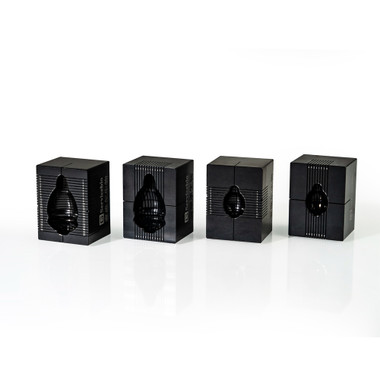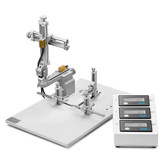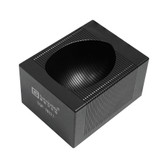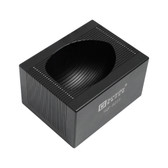 Loading... Please wait...
Loading... Please wait...- Call us on 443-686-9618
- Wish Lists
- My Account
- 0.00
Categories
- Home
- Stereotaxic Instruments
- Brain Slicing Mold for Mouse and Rat
Brain Slicing Mold for Mouse and Rat
Product Description
Used for obtaining coronal and sagittal thin sections of brain tissue; precise in size, with flat and even cuts, and consistent thickness, ensuring reproducibility in the slicing process.
The animal brain section mold is primarily used for preparing specific sections of animal brain tissue. Our company offers two types of brain section molds for rat and mouse brains: coronal sections perpendicular to the midline of the brain and sagittal sections parallel to the midline of the brain. With options of 1mm and 0.5mm slice thicknesses, these molds are made of high-quality aluminum alloy, ensuring precise dimensions, flat and uniform cuts, and reproducibility in the section process. Customization for other animal brain tissue section molds, such as monkey, pig, chicken, duck, rabbit, and guinea pig, is also available.
|
Cat.No. |
Spec. |
||
|
Applicable Animal |
Section Direction |
Section Thickness (mm) |
|
|
SQP-H12 |
Mouse |
Brain, coronal section |
1 mm |
|
SQP-H23 |
Rat |
Brain, coronal section |
1 mm |
|
SQP-Z9 |
Mouse |
Brain, sagittal section |
1 mm |
|
SQP-Z13 |
Rat |
Brain, sagittal section |
1 mm |
|
SQP-H21 |
Mouse |
Brain, coronal section |
0.5 mm |
|
SQP-H37 |
Rat |
Brain, coronal section |
0.5 mm |
|
SQP-Z15 |
Mouse |
Brain, sagittal section |
0.5 mm |
|
SQP-Z21 |
Rat |
Brain, sagittal section |
0.5 mm |
Each section mold includes a set of 5 blades (G7099-80).
Product Features
1.Made of high-quality aluminum alloy, resistant to high temperatures, easy to clean, and durable.
2.Digitally engraved markings for easy positioning, with a cut slot width of 0.35mm and a spacing of 1mm.
3.Two specifications available: coronal section mold perpendicular to the brain midline and sagittal section mold parallel to the brain midline.
4.Coronal brain molds feature a sagittal midline for easy separation of left and right hemispheres.
Application Fields
For initial positioning of fixed brain tissue, facilitating precise section positioning for paraffin sections, frozen sections, vibratome sections, and ultrathin sections.
For positioning fresh brain tissue, combined with brain atlases for initial localization of neuronal nuclei and special areas, and sampling target tissue samples for protein, molecular, biochemical, and other detection analyses. Such as research on neurotransmitter and metabolite concentration levels.
Usage Instructions
1.Place the stripped or fixed animal brain tissue into the corresponding mold groove according to the section direction and tissue shape, ensuring that the base of the olfactory bulb aligns with the base of the mold for better positioning.
2.Determine the section area, insert two paraffin section blades (G7099-80 recommended) into the section grooves on both sides of the target tissue area, press both ends of the blades to the bottom of the groove simultaneously, and cut the tissue. Pull the blades out from the side and use tweezers to gently remove the cut brain section for subsequent experiments.
3.Remove the remaining tissue in the groove, wash the mold with water, and let it air dry for future use.
4.When using the mold for mouse brain section, insert multiple single-edged blades sequentially into the brain tissue, then pour out the brain and sections together from the mold to achieve efficient and convenient separation of single brain specimens.
(For fresh tissue, to facilitate section and prevent tissue adhesion to the mold, it is recommended to freeze the mold in a -20°C freezer before section.)
Recommended section Areas for Common Brain Regions
(For mouse brains weighing 20-30g, with the base of the olfactory bulb aligned with the base of the mold on the coronal slice)
|
Region Name |
Corresponding Range on the Mold |
Slice Location on the Mold |
Fine section Location for Paraffin/Frozen/Vibratome Sections |
|
Olfactory Bulb |
1-2 |
Cut at the lower groove line 2 |
Start section from the top groove line 1 |
|
Prefrontal Cortex |
3-4 |
Cut at the upper groove line 3 and lower groove line 4 |
Start section from the upper groove line 3 |
|
Striatum |
4-5 |
Cut at the upper groove line 4 and lower groove line 5 |
Start section from the upper groove line 4 |
|
Amygdala |
5-6 |
Cut at the upper groove line 5 and lower groove line 6 |
Start section from the upper groove line 5 |
|
Dorsal Hippocampus, Thalamus, Hypothalamus |
6-7 |
Cut at the upper groove line 6 and lower groove line 7 |
Start section from the upper groove line 6 |
|
Ventral Hippocampus and Substantia Nigra |
6-7 |
Cut at the upper groove line 6 and lower groove line 7 |
Start section from the lower groove line 7 |
|
Cerebellum |
9-11 |
Cut at the upper groove line 9 and lower groove line 11 |
Start section from the upper groove line 9 |
Note: The intersection of the lower groove line 4 and the sagittal midline approximates the bregma. For section other special areas, refer to the mouse brain atlas for initial positioning.







